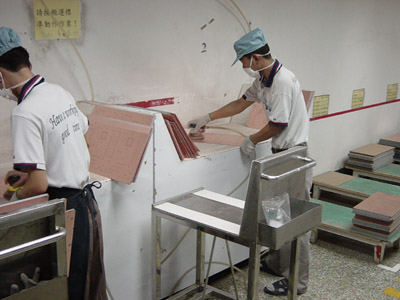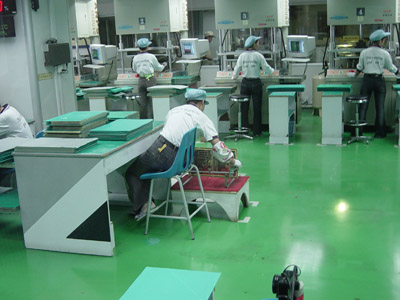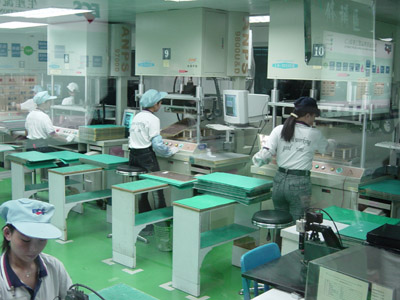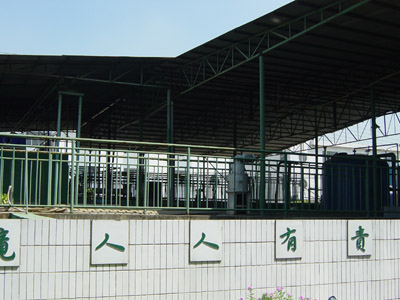Inside Elitegroup Computer Systems: From Taipei to Shen Zhen
by Kristopher Kubicki on October 4, 2003 12:39 PM EST- Posted in
- Motherboards
Biloda PCB: OS Testing and Lithography
Click to enlarge.
Finally, the drilled boards are scrubbed. Up until now, this is the first time we've seen male workers in the factory. In case you are interested in knowing what is on the shirt of the man on the left, it says, "Have a working good time." I emailed Anand if we could get polo shirts with that motto on it, but I did not get a response.
The majority of the small drill holes are filled with the particular solder or copper through chemical lithography. The motherboard circuitry itself is "printed" right on the board using large machines that somewhat resemble Xerox copiers. A negative image of the circuitry is placed over the board, and then a chemical process removes the exposed top layer not covered by the negative. A resulting circuit is produced. Workers flip the board and repeat the process to create a double-sided circuit board.
Click to enlarge.
Now this thing is starting to look more like (two) motherboards! After the board is done printing, it immediately goes across the hall to the OS testing room. The QA on the motherboard line really picks up at this point. These large machines take the motherboards and press a matching circuit design on the top and bottom. A current is passed through and the monitor tells the worker whether or not all electrical paths are correct.
The next (immediate) room contained the print facilities. Although I can't exactly describe what this guy is doing, I believe the process is somewhat similar to silk screening. This particular red dye is being applied over some PC Chips motherboards. One thing that struck us as odd is that there has been a surprising amount of manual labor up to this point. Considering the extremely cheap cost of workforce, it certainly must be cheaper and more effective to use manual labor in a high volatile sector like the motherboard industry. ECS was very proud to let us know that tooling a motherboard into full production only takes seven days from receiving the CAD/CAM layout from ECS Taipei. Certainly an impressive fact, although it's quite obvious that the only changes that are really needed (besides loading the software in the drilling machines) are with the manual laborers.
In any case, the factory itself does seem safe extremely considering all of the manual labor around. No doubt the monthly safety record is written in English as well as Chinese so that nosy American reporters will take a picture of it.
Click to enlarge.
Finally, as we left Biloda, we got one scenic shot of the onsite water treatment facility. All of those plastics, oxides and dyes need to be treated before they are dumped back into the ocean. Regardless of the fact that no one else within a 30 mile radius seemed to care at all about any sort of pollution control, Biloda does a very good job of providing adequate environment awareness. In fact, our tour guide went into a 20 - 30 minute analysis of it; but, we really want to see what's going to happen to these motherboards, so let's skip that part for now.















30 Comments
View All Comments
Anonymous User - Monday, October 6, 2003 - link
"Quote # 19"Anonymous User - Sunday, October 5, 2003 - link
#17-Most people RMA products because they are ignorant fools who should be buying Dells.Anonymous User - Sunday, October 5, 2003 - link
Is it a misprint, or do 50% of the originally manufactured bare motherboards fail QA? If that's true, you think they could figure out what the single biggest problem there is, fix it, and drop the fail rate to 20% or something. Yeesh. This article makes it seem like a miracle that their motherboards even work at all.I was going to mention how terrible a job sticking SIMM/DIMM connectors onto motherboards, all day, every day, for $150 a month would be, but then I thought there are a lot worse ways these women could be forced to make money.
AgaBooga - Sunday, October 5, 2003 - link
Any response to #7?Anonymous User - Sunday, October 5, 2003 - link
#9 you ignorant slut...since it is impossible to get the truth about employment practices, manufacturing practices (although the article alludes to how others around ECS are polluting)or just about anything else in china your statements just show you to be an apologist for a corrupt and tyrannical system...
i can guarantee that there are no 'lazy' workers over there, a mistake or two on the line and you go back to the rice paddy and another slave takes your place - one hell of a motivator...
Anonymous User - Sunday, October 5, 2003 - link
Nice article although ECS and it's affiliates still produce some of the worst motherboards I have ever used.Anonymous User - Sunday, October 5, 2003 - link
A very interesting article.What is surprising is that it is not more mechanized and that there is so much (wo)manual labor involved!As far as the cost of labor is concerned.It may be likely that $150 is considered a good wage in ChinaAnonymous User - Sunday, October 5, 2003 - link
A very great article, I knew that ECS was a large company. But not that large and I did´nt know that they have had Matsonic and PC Chips.The article could have been much more with their mainboards and Notebooks Espacially about the QA, and production technics.
#6 ECS Produce ALOT of mainboards it is somewhat impossible to garantee a mainboard that is not defetive, or an entire shipment.
Here they article could give us some insight on what happens with RMA mainboards at ECS, this would defently provide some insight what a mainboard manufactor do with these mainboards.
#11, I agree with you.
#9, to the part of the postoffice, I can only say this. In the US the law require that a Coperate Employer also hire Minority Groups in giving %.
Anonymous User - Sunday, October 5, 2003 - link
#6, you're an idiot, stop posting.DAVIDS - Sunday, October 5, 2003 - link
#9, I think you're making a lot of over-generalizations about American workers. Lazy people can be found in every country. There are a lot of American workaholics who spend 50-60 hours/week on the job. Also, you seem to forget that many of the technological innovations found in computers were made by researchers here in the US. The microprocessor, random access memory, etc. are all American inventions.